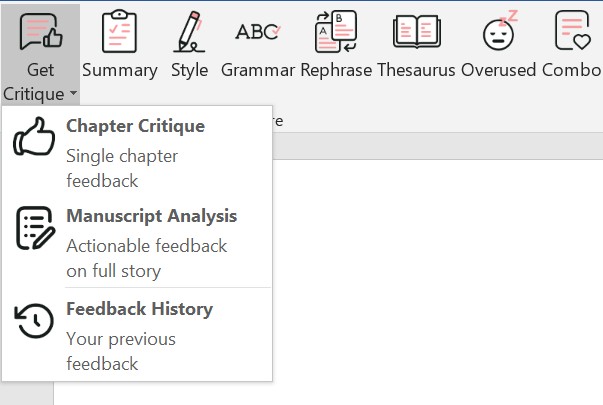
Several years ago, I successfully participated in NaNoWriMo. The reward was a discount of a lifetime membership to ProWritingAid, and hence my ProWritingAid experience began. I’ve since enjoyed many features, such as Chapter Critique and Realtime options. Now ProWritingAid has included a new element designed to further improve writer assistance. It’s called Manuscript Analysis.
But what is a manuscript analysis service?
This service provides expert manuscript assessments, highlighting strengths and weaknesses. It also offers practical advice for improvement to boost publication or completion chances.
Now, ProWritingAid has made this available to all with a single click. Yet, does it live up to its creators’ standards? Let’s check it out.
Manuscript Analysis by ProWritingAid
ProWritingAid’s new Manuscript Analysis tool offers affordable, on-demand, in-depth manuscript feedback and guidance. It is an optional feature to assist writers and editors in enhancing manuscripts.
Note that it is not a replacement for human feedback.
Manuscript Analysis Features
Manuscript Analysis provides a thorough analysis of your story’s characters, plot, and setting, pinpointing key areas for improvement and justifying its recommendations.
It is divided into these sections:
- About my story: This section gives key insights into your manuscript in the form of:
- Story Overview: It displays the story’s genre, blurb, and a numbered plot outline.
- Narrative Elements: This section focuses on the manuscript’s setting, themes, and motifs.
- Competitive Landscape: Here you will find your potential readers and books that have similarities with yours.
- Characters: It offers crucial details about your characters like their role, type, and story presence. Novels with comparable characters are also included.
- Table of contents: Besides listing chapters, the table of contents also provides each chapter’s title (based on the content), narrative purpose, and point of view. At least, it did for me.
- Plot & Structure: This section pinpoints effective plot points and areas needing improvement.
- Characters: This section reviews key moments of character development, noting where characters are successful and where improvement is needed.
- Setting: This section determines how your setting enhances the manuscript’s storytelling. It highlights areas in your setting that need improvement and suggests ways to enhance them.
The plot & structure, characters, and setting sections pinpoint the exact location of the analysis. While the entire “about my story” section is highlighted in blue, the other sections are color-coded. Each analysis is given a different color based on the concern level. Suggested improvements are provided for all colors except green.
Manuscript Preparation
To get the most out of Manuscript Analysis, prepare your manuscript using the following steps:
- Submit your manuscript as one document.
- Ensure your manuscript’s word count falls between 4,000 and 300,000 words. Exceeding this may not produce the best outcome.
- Make sure there’s a clear division between chapters. Numbering chapter titles will give you the best results. If chapter titles are not numbered, avoid scene or subsection headings. Manuscript Analysis might consider this scene a chapter.
- The chapter heading should start on a new line, with a blank line above it.
Note that ProWritingAid uses AI to analyze texts and provide feedback in its analysis of manuscripts. AI requires clear guidelines or rules to understand and interpret texts.
Pros and Cons of ProWritingAid’s Manuscript Analysis
Pro: It is very easy to use. Just hit the ProWritingAid button, then select Get Critique from the main menu. A dropdown menu will appear, with Manuscript Analysis among the choices. Once you click that, you’re set.

Pro: The color scheme makes it simple to locate the most critical problems. You can use this to prioritize your edits. Or not.
Pro: This add-on pinpoints the exact location of the analysis. This can save you considerable time and reduce frustration.
Pro: What I love most about Manuscript Analysis is that it not only tells you what is concerning but also provides actionable suggestions. It helps you find exactly where your manuscript needs work by offering chapter-specific insights and pointing out plot holes, inconsistencies, and world-building issues.
Pro: Manuscript Analysis is automatically saved in your feedback history. This offers easy and convenient access. You can also print and download your analysis as a PDF file.
Con: Each use requires one credit which you can purchase through ProWritingAid. While these credits are not refundable, they never expire and you can purchase individual credits, as well as credit bundles. However, the cost varies depending on your premium.
Free users:
- 1 credit: $50
- 3 credits: $145
- 10 credits: $450
Premium users:
- 1 credit: $35
- 3 credits: $100
- 10 credits: $300
Premium Pro users:
- 1 credit: $25
- 3 credits: $70
- 10 credits: $175
Pro: While Manuscript Analysis has usage fees, it remains cheaper than professional human analysis. Analyzing a manuscript usually costs between $0.016 and $0.025 per word, or at least $40 hourly. Total prices can range from $500 to $2000, depending on the manuscript’s length.
Conclusion: Assessment
ProWritingAid has introduced a potentially game-changing Manuscript Analysis feature for authors. This tool offers affordable and detailed manuscript feedback and guidance of 4000 to 300,000 words on demand. Manuscript Analysis provides a thorough examination of characters, setting, plot, and structure.
As with other features, there are advantages and disadvantages. The intuitive design and color scheme make identifying critical problems easy, with automatic feedback history saving. Besides the location of the analysis, it provides useful, actionable suggestions. There is a downside, however. Every use requires a credit which costs money, though it is cheaper than a human professional will cost. Ultimately, I believe the advantages far surpass the drawbacks. But what do you think?
“A good tool improves the way you work. A great tool improves the way you think.”
Jeff Duntemann
